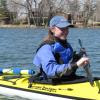 This book, winner of the 2005 Roderick Haig-Brown BC Book Prize is a must read for anyone concerned about the controversies surrounding farmed fish on the west coast.
This book, winner of the 2005 Roderick Haig-Brown BC Book Prize is a must read for anyone concerned about the controversies surrounding farmed fish on the west coast.
Stephen Hume, Alexandra Morton, Betty C. Keller, Rosella M. Leslie, Otto Langer, and Don Staniford all weigh in on the numerous threats posed by salmon farming to our wild Pacific salmon.
Stephen Hume, an award winning journalist, starts off the first chapter describing how he first heard about rumours that something dreadful was happening in the Broughton Archipelago where pink salmon runs were simply not showing up and that fish farms and sea lice congregating around fish farms might be playing a crucial role in diminishing the ability of wild salmon smolts to survive. Hume describes the beginnings of his research,“As I began fishing for answers, I found myself on a journey not unlike that of the salmon themselves, a journey that began on the spawning beds of little-known BC rivers, took me halfway around the world and brought me back, eventually, to the river where my own memories began.”
Hume eloquently describes the concerns of Heiltsuk and Nuxalk elders from the central coast and their zero tolerance toward open net cage salmon farms in their traditional territories. He interviews many of the people involved not only in the fish farm industry itself but scientists, environmentalists and crusaders for a more sustainable aquaculture industry. Traveling to Europe and the entire BC coast in search of answers he is adept at putting all sides of the issue into a very readable format but in the end he concludes that, “Now is the time for more of us to assert ourselves on behalf of our wilderness, parks and wildlife. Salmon farmers and other industries need to hear the message loud and clear: Operate safely, safely, sustainably and disease free and prove there is no risk to wild salmon stocks or take the business somewhere else.”
Don Staniford’s essay, entitled, Silent Spring of the Sea, quotes Rachel Carson’s prescient warning back in 1962: “What we have to face is not an occasional dose of poison which has accidentally got into some articles of food, but a persistent and continuous poisoning of the whole human environment.”
Staniford goes on to say that salmon farmer’s response to the disease and parasite problem has typically not been to reduce stocking densities, scale back on production or leave the sea bed fallow so it can recover. Instead they have resorted to an ever more powerful arsenal of dangerous and hazardous weapons, pressuring agricultural chemical companies to develop novel treatments for use in aquaculture.
I must confess that his descriptions of the chemical soup prevalent in net cage salmon farming was hard to digest and so I moved on to the next essay somewhat unnerved by the long list of toxic chemicals used with little or no regard to their effect on the environment surrounding the fish farms.
Betty Keller and Rosella M. Leslie explain the development of the industry in BC, from small family operations to large chain farms owned by a handful of multinational conglomerates.
Otto Langer, formerly with DFO, offers a blueprint for change after explaining in his chapter how conflicting mandates, poor habitat oversight and the seemingly disdainful disregard for what many people feel is an ecological disaster that got us into this mess in the first place.
Biologist Alexandra Morton has the last word as she documents her extensive research, the forming of the Coastal Alliance for Aquaculture Reform, and her frustration with the various bureaucracies’ ineptitude at coming up with solutions to the environmental problems associated with fish farms in her back yard, the Broughton Archipelago.
One commercial fisherman, after the collapse of the mainland inlet pink salmon runs in 2002, was quoted as saying, “I guess the scary thing is that Alex Morton predicted this would happen back in 2000. And she was right. Now she’s predicting extinction. I don’t think we can afford to wait to see if she’s right again.”
The book starts with an introduction by David Suzuki, a preface by Terry Glavin and concludes with a seven-point action plan to resolve the hazards of salmon farming.
After reading this book, and I know one of the authors as well as a number of the people mentioned in Stephen Hume’s essay, it is has become quite clear to me that the time to transition to closed containment salmon aquaculture here on the coast is long overdue.
 rs from the ports of Long Beach and Los Angeles, the state of California, and Foss Maritime Company, who gathered with business, government and media representatives to welcome the world’s first true hybrid tug, Foss’ Green Assist™, to southern California. at the Foss berth on Pier D at the
rs from the ports of Long Beach and Los Angeles, the state of California, and Foss Maritime Company, who gathered with business, government and media representatives to welcome the world’s first true hybrid tug, Foss’ Green Assist™, to southern California. at the Foss berth on Pier D at the 


















